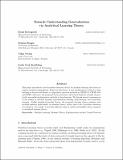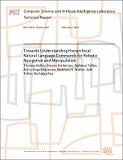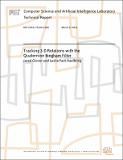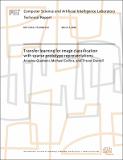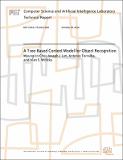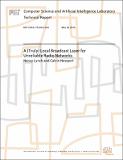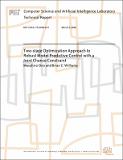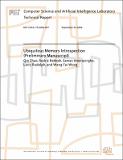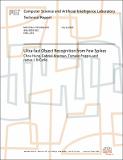Browsing CSAIL Digital Archive by Title
Now showing items 737-756 of 806
-
Towards Understanding Generalization via Analytical Learning Theory
(2018-10-01)This paper introduces a novel measure-theoretic theory for machine learning that does not require statistical assumptions. Based on this theory, a new regularization method in deep learning is derived and shown to ... -
Towards Understanding Hierarchical Natural Language Commands for Robotic Navigation and Manipulation
(2011-02-01)We describe a new model for understanding hierarchical natural language commands for robot navigation and manipulation. The model has three components: a semantic structure that captures the hierarchical structure of ... -
Tracking 3-D Rotations with the Quaternion Bingham Filter
(2013-03-27)A deterministic method for sequential estimation of 3-D rotations is presented. The Bingham distribution is used to represent uncertainty directly on the unit quaternion hypersphere. Quaternions avoid the degeneracies of ... -
Trading Structure for Randomness in Wireless Opportunistic Routing
(2007-02-23)Opportunistic routing is a recent technique that achieves high throughput in the face of lossy wireless links. The current opportunistic routing protocol, ExOR, ties the MAC with routing, imposing a strict schedule on ... -
Tragedy of the routing table: An analysis of collective action amongst Internet network operators
(2011-08-06)This thesis analyzes and discusses the effectiveness of social efforts to achieve collective action amongst Internet network operators in order to manage the growth of the Internet routing table. The size and rate of growth ... -
Trajectory Analysis and Semantic Region Modeling Using A Nonparametric Bayesian Model
(2008-06-24)We propose a novel nonparametric Bayesian model, Dual Hierarchical Dirichlet Processes (Dual-HDP), for trajectory analysis and semantic region modeling in surveillance settings, in an unsupervised way. In our approach, ... -
Transductive Ranking on Graphs
(2008-08-07)In ranking, one is given examples of order relationships among objects, and the goal is to learn from these examples a real-valued ranking function that induces a ranking or ordering over the object space. We consider the ... -
Transfer learning for image classification with sparse prototype representations
(2008-03-03)To learn a new visual category from few examples, prior knowledge from unlabeled data as well as previous related categories may be useful. We develop a new method for transfer learning which exploits available unlabeled ... -
Transfering Nonlinear Representations using Gaussian Processes with a Shared Latent Space
(2007-11-06)When a series of problems are related, representations derived fromlearning earlier tasks may be useful in solving later problems. Inthis paper we propose a novel approach to transfer learning withlow-dimensional, non-linear ... -
Transferring Nonlinear Representations using Gaussian Processes with a Shared Latent Space
(2008-04-11)When a series of problems are related, representations derived from learning earlier tasks may be useful in solving later problems. In this paper we propose a novel approach to transfer learning with low-dimensional, ... -
Transparent Accountable Data Mining: New Strategies for Privacy Protection
(2006-01-27)Attempts to address issues of personal privacy in a world of computerized databases and information networks -- from security technology to data protection regulation to Fourth Amendment law jurisprudence -- typically ... -
A Tree-Based Context Model for Object Recognition
(2010-10-29)There has been a growing interest in exploiting contextual information in addition to local features to detect and localize multiple object categories in an image. A context model can rule out some unlikely combinations ... -
A (Truly) Local Broadcast Layer for Unreliable Radio Networks
(2015-05-18)In this paper, we implement an efficient local broadcast service for the dual graph model, which describes communication in a radio network with both reliable and unreliable links. Our local broadcast service offers ... -
Two-stage Optimization Approach to Robust Model Predictive Control with a Joint Chance Constraint
(2008-03-06)When controlling dynamic systems such as mobile robots in uncertain environments, there is a trade off between risk and reward. For example, a race car can turn a corner faster by taking a more challenging path. This paper ... -
Typesafety for Explicitly-Coded Probabilistic Inference Procedures
(2017-11-09)Researchers have recently proposed several systems that ease the process of developing Bayesian probabilistic inference algorithms. These include systems for automatic inference algorithm synthesis as well as stronger ... -
Ubiquitous Memory Introspection (Preliminary Manuscript)
(2006-09-25)Modern memory systems play a critical role in the performance ofapplications, but a detailed understanding of the application behaviorin the memory system is not trivial to attain. It requires timeconsuming simulations of ... -
UCM/MIT Indications, Referring Expressions, and Coreference Corpus (UMIREC corpus)
(2010-05-12)This version of the UMIREC corpus has been superseded by version 1.1, found at http://hdl.handle.net/1721.1/57507. Please do not use version 1.0, as it contains corrupted coreference information. The correct, uncorrupted ... -
UCM/MIT Indications, Referring Expressions, and Coreference Corpus (UMIREC corpus) v1.1
(2010-05-12)The corpus comprises 62 files in "Story Workbench" annotation format: 30 folktales in English from a variety of sources, and 32 Wall Street Journal articles selected to coincide with articles found in the Penn Treebank. ... -
Ultra-fast Object Recognition from Few Spikes
(2005-07-06)Understanding the complex brain computations leading to object recognition requires quantitatively characterizing the information represented in inferior temporal cortex (IT), the highest stage of the primate visual stream. ... -
Understanding and evaluating blind deconvolution algorithms
(2009-03-31)Blind deconvolution is the recovery of a sharp version of a blurred image when the blur kernel is unknown. Recent algorithms have afforded dramatic progress, yet many aspects of the problem remain challenging and hard to ...

